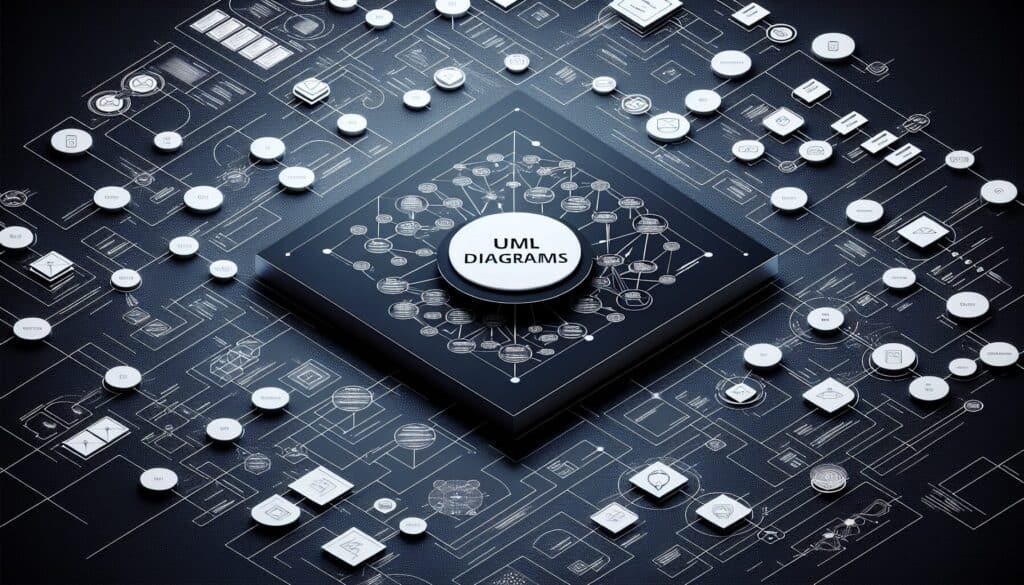To provide a standard way to visualize the design of a system.
- Metodologie: Clienti e marketing, Economia, Progettazione del prodotto
Diagrammi UML

Diagrammi UML
- Documentazione di progettazione, Processo di progettazione, Pensiero progettuale, Gestione del progetto, Sistema di gestione della qualità (SGQ), Kit di sviluppo software (SDK), Ingegneria del software, Linguaggio di modellazione dei sistemi (SysML), Linguaggio di modellazione unificato (UML)
Obiettivo:
Come si usa:
- Uses a set of graphical notations to create visual models of software systems, including their structure, behavior, and interactions. Different types of UML diagrams (e.g., class, sequence, use case) serve different purposes in the software development lifecycle.
Professionisti
- Standardized and widely understood; Improves communication among stakeholders; Helps in identifying potential flaws early in the design process; Supports various stages of software development.
Contro
- Can be complex and time-consuming to create and maintain, especially for large systems; Some diagrams can be difficult for non-technical stakeholders to understand; Risk of over-modeling or creating unnecessary diagrams.
Categorie:
- Ingegneria, Progettazione del prodotto, Gestione del progetto
Ideale per:
- Visualizing, specifying, constructing, and documenting the artifacts of a software-intensive system.
UML (Unified Linguaggio di modellazione) diagrams serve as a foundational tool in software engineering, providing a graphical representation of various aspects of systems that enhances both understanding and documentation. They are utilized extensively across industries such as aerospace, automotive, healthcare, and information technology to depict everything from system architecture to process flows and user interactions. For instance, in the healthcare sector, use case diagrams can illustrate patient interaction with medical software systems, while class diagrams can detail the underlying database structures. Various stakeholders such as business analysts, developers, project managers, and system architects engage with UML diagrams during critical phases of a project, such as requirements gathering, system design, and during the implementation of Agile and DevOps methodologies. This collaborative approach facilitates effective communication, ensuring that technical and non-technical team members align on project goals and specifications. The standardization brought by UML also aids new team members or cross-functional teams in quickly assimilating project knowledge, as the visual representation provides an intuitive understanding of the system’s components and their relationships. Beyond visualization, UML diagrams assist in modeling dynamic behaviors and interactions among different system parts, helping to identify potential design flaws, inefficiencies, or areas of risk early in the development cycle. Additionally, the broad acceptance of UML across various educational platforms enhances the ease of creating interchangeability within teams, aiding in smoother transitions between phases like design to implementation or testing.
Fasi chiave di questa metodologia
- Identify the purpose and scope of the system.
- Define the key stakeholders and their requirements.
- Select appropriate UML diagrams for representation.
- Create use case diagrams to outline interactions and functionalities.
- Develop class diagrams to illustrate system structure and relationships.
- Produce sequence diagrams to detail object interactions over time.
- Refine diagrams based on feedback and iterative review.
- Ensure diagrams are up to date with design changes.
- Integrate UML diagrams into system documentation.
- Utilize diagrams for code generation and testing phases.
Suggerimenti per i professionisti
- Utilize stereotypes and tagged values in class diagrams to provide additional semantic clarity, enhancing communication about model specifics.
- Employ sequence diagrams to validate interactions, ensuring that all use case scenarios are captured, which can reveal hidden dependencies among components.
- Incorporate iterative feedback loops with stakeholders during UML diagram reviews to align expectations and uncover design flaws earlier in the lifecycle.
Leggere e confrontare diverse metodologie, raccomandiamo il
> Ampio archivio di metodologie <
insieme ad altre 400 metodologie.
I vostri commenti su questa metodologia o ulteriori informazioni sono benvenuti su sezione commenti qui sotto ↓ , così come tutte le idee o i link relativi all'ingegneria.
Contesto storico
1828
1850
1854
1854
1911
1928
1950
1827
1848
1850
1854
1895
1914
1943
1970
(se la data non è nota o non è rilevante, ad esempio "meccanica dei fluidi", viene fornita una stima approssimativa della sua notevole comparsa)















Post correlati
Gestione delle operazioni di produzione (MOM)
Sistema di esecuzione della produzione (MES)
Piano di controllo della produzione
Test manuali
Schede di valutazione della movimentazione manuale (MAC)
ManTRA (Strumento di valutazione dei rischi delle attività manuali)